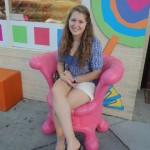 The classroom that I’m in has a lead teacher, three Therapeutic Staff Supports (TSS’s), and five Personal Care Assistants (PCA’s) to teach eight children with autism ranging in age from kindergarten (six years old) to sixth grade (twelve years old). All of the children are at different points on the spectrum—some have verbal ability, some only sign, and some go to typical classrooms for certain subjects. Rather than desks, each student has their own cubicle with a table, a chair for them, and a chair for the teacher/PCA. At each student’s cubicle is a set of three drawers to hold cards for ABA, data sheets, the program outline, and reinforcers.
The classroom that I’m in has a lead teacher, three Therapeutic Staff Supports (TSS’s), and five Personal Care Assistants (PCA’s) to teach eight children with autism ranging in age from kindergarten (six years old) to sixth grade (twelve years old). All of the children are at different points on the spectrum—some have verbal ability, some only sign, and some go to typical classrooms for certain subjects. Rather than desks, each student has their own cubicle with a table, a chair for them, and a chair for the teacher/PCA. At each student’s cubicle is a set of three drawers to hold cards for ABA, data sheets, the program outline, and reinforcers.
The front of the classroom has a white board that is used as the schedule. Across the top are the PCAs’ names along with the teacher’s name and down the side are the time slots. Most of the time slots are twenty minutes and each student has a specific color paper with their name on a magnet which is placed under a specific PCA or the teacher with another magnet that says what they’ll be doing at that time—manding, tacting, peer-to-peer manding, play skills, ITT (Intensive Table Teaching), speech language pathology, occupational therapy, inclusion, fluency, or a specific subject area. Every morning the whole class goes to special—art, music, library, physical education, or computer for forty minutes.
Routine is very important for children with autism which is why the schedule is on the board and organized. One of the students in the class comes in every morning and memorizes the schedule and if something changes during the day, he gets upset. The classroom is very structured for the sensitivities that the students have which is part of why it is so efficient. Another reason why the classroom is so efficient is the dedication of the staff—they are caring, understanding, intuitive, smart, creative, and innovative.
Now is a very pivotal time for autism because the DSM-V came out a few weeks ago and they have changed the definition of the psychological disorder and its conditions. One term for autism will be used—Autism Spectrum Disorder which will then be broken into three levels: one, two, and three. Asperger’s Syndrome and PDD-NOS have been eliminated. It will be interesting to see how this change affects the services children can receive.
